
Station Name: SPROUSTON
Sprouston Station Gallery 1: c1942 - c1965  During World War 2 (1939-45) the engine shed at Sprouston, officially closed since 1916, was used to store GWR City Class 4-4-0 No.3440 ‘City of Truro’; it was moved to this place of safety from York Railway Museum. Here the venerable locomotive is under a protective covering and is being shunted out of the shed.
Photo from R W Lynn collection  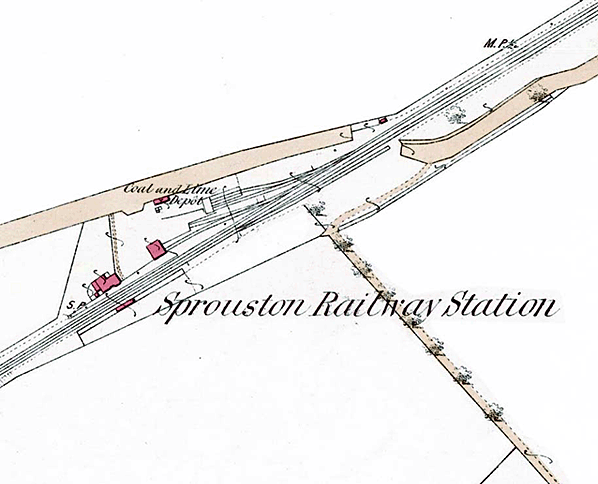 1863 OS 1:2,500 map. Sprouston station is close to the eastern edge of the village of this name and south-west of a level crossing. The station building is shown on the up (north-west, Berwick-bound) platform with a waiting shed opposite on the down platform. A goods warehouse is shown behind the north-eastern end of the up platform. A two-road ‘Coal and Lime Depot’ is also located on the up side of the line. 1863 OS 1:2,500 map. Sprouston station is close to the eastern edge of the village of this name and south-west of a level crossing. The station building is shown on the up (north-west, Berwick-bound) platform with a waiting shed opposite on the down platform. A goods warehouse is shown behind the north-eastern end of the up platform. A two-road ‘Coal and Lime Depot’ is also located on the up side of the line.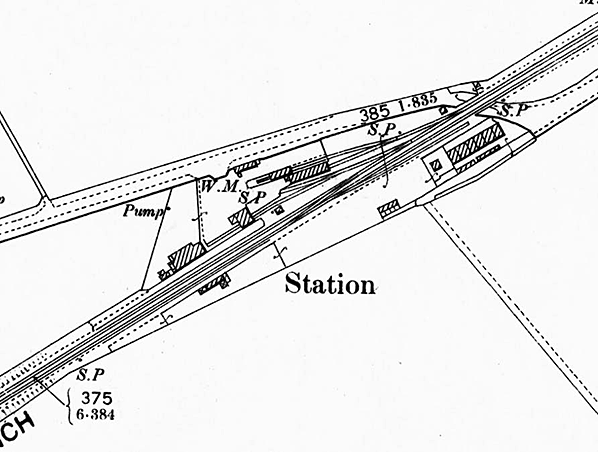
1898 OS 1: 2,500 map. This map shows the engine shed adjacent to the coal and lime depot (named on the 1863 map). Although the original engine shed was constructed in 1863 it was not shown on that year’s map, and the shed shown here replaced the storm-damaged first shed. The first signal box is shown (but not named) immediately west of the level crossing on the up (north-west) side of the tracks. The first terrace of railway cottages, constructed c1860s is close to the crossing.
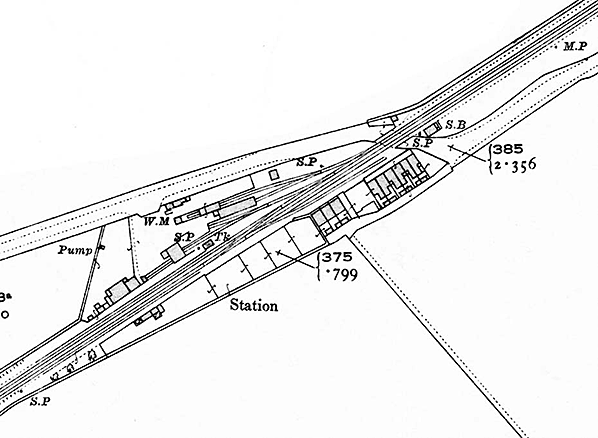 1921 OS 1:2,500 map. The most significant change is the provision of a second row of railway cottages on the down side of the tracks, south-west of the first row. The signal box built in 1912 is indicated immediately north-east of the crossing on the down side; it replaced the original box on the opposite side of the tracks. The coal and lime depot is not named but the weigh office (‘W.M.’ = weighing machine) is labelled at the south-western end of the depot. The engine shed (not named) with the single railway track extending through it closed in 1916 but would remain in place until the mid 1960s.
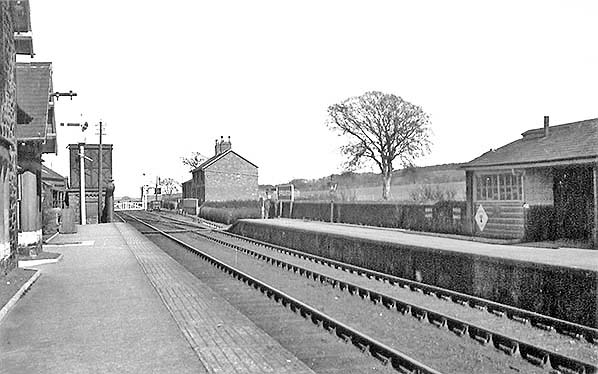
Sprouston station looking north-east c1950 from the up platform. The stationmaster’s house and offices are left foreground, and beyond are the water column and tank. The waiting shed on the down platform is of NER provenance and has a masonry front to the enclosed section. The two terraces of railway staff cottages are to the right of the level crossing. They are of distinctly different design: the nearer terrace, built of brick c1900, is substantially taller than the older row beyond which it partly conceals.
Photo from John Mann collection 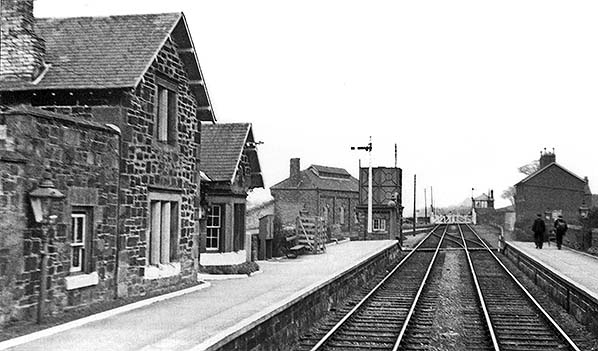
Sprouston station looking north-east on 26 April 1952. The substantial buildings on the left (up) platform combine the stationmaster’s two-storey house and single-storey offices. Beyond the end of this platform the water tank, water column and disused engine shed are visible. The station is lit by oil and elegant, post-mounted lanterns can be seen on both platforms. In the distance, beyond the down platform, are the c1900 terrace of railway staff cottages, the signal box and the level crossing.
Photo by J W Armstrong from Armstrong Railway Photographic Trust 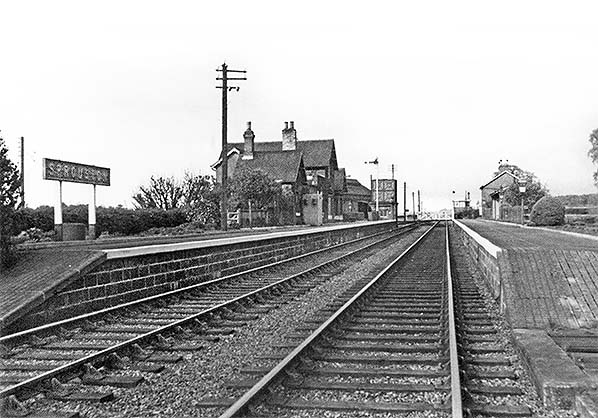
Sprouston station looking north-east on 14 March 1955. By this date the station has been earmarked for closure to passengers, and this would take effect a little under four months later. The station appears well maintained and its buildings and fittings can be enjoyed on this well-composed photograph.
Photo by C J B Sanderson from the Armstrong Railway Photographic Trust collection 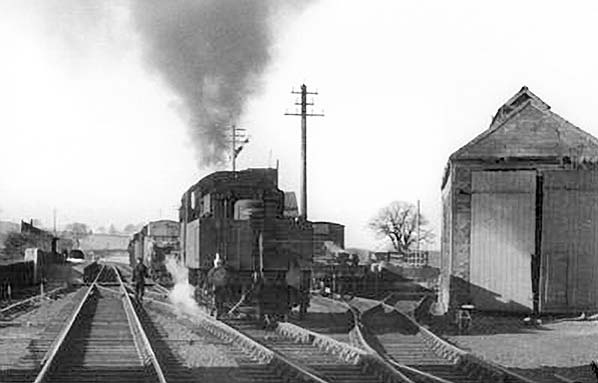 On an unknown date in the 1950s or early 1960s a BR 2MT 2-6-0 is on shunting duties at Sprouston station. The former engine shed is to the right.
Photo from Alan Young collection 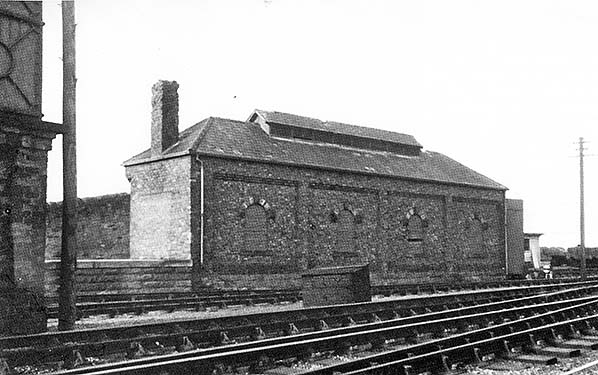
The former single-road engine shed at Sprouston looking north in August 1959. This brick building replaced an earlier timber shed that collapsed during a gale on 14 October 1881. It would stand for a few more years and is understood to have been demolished at some point between 1964 and 1968. The water tank creeps into this view, left foreground.
Photo by R S Carpenter
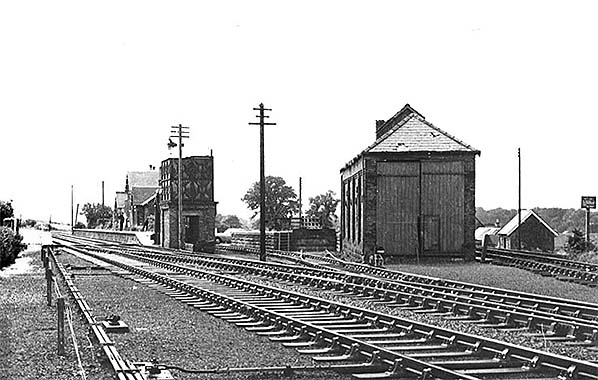
Looking south-west towards Sprouston station and goods yard from the level crossing in August 1964. The engine shed seen on the right has been devoid of a shed road for many years. The goods dock with side and end loading is seen between the shed and the water tank. The siding to the right of the goods shed ran alongside another dock. The water tank would be removed with a year - see picture below.
Photo from Roger Griffiths collection 
Looking north-east at Sprouston, with the disused passenger station immediately behind the camera. The tracks are rusty, suggesting that the photo dates from late summer 1965, several months after the line closed to all traffic. The signal box closed in March 1965, and the cabin (right of the tracks, beside the crossing) has been demolished leaving only the brick base and chimneystack. In the foreground is the brick plinth that formerly carried the water tank. A corner of the disused engine shed is seen beyond it. The two rows of railway staff cottages are right of the tracks; the more distant terrace (thought to date from the 1860s) is stone built and the taller, brick-built block was constructed c1900. Since the picture above, taken in August 1964, the sidings have been lifted and the points replaced with new track.
Photo by Morrison Halbert from Roy Lambeth collection / ARPT collection  Although closed to passengers since 1955, this south-westward view - possibly in late summer 1965, several months after complete closure of the branch from Tweedmouth to Kelso – shows Sprouston station’s platforms and buildings extant; only the removal of platform lamps indicates that passenger trains no longer call here. The generously sized building on the right (up) platform is of uncoursed stone and combines a two-storey stationmaster’s house with offices and other facilities in the two flanking single-storey wings. The overhanging roofs at the two levels create a pleasing, balanced elevation to the buildings. The far more modest waiting shed on the down platform is almost concealed from view. The goods yard at Sprouston remained in use until January 1965; since June 1964 it had been an unstaffed public siding. Although closed to passengers since 1955, this south-westward view - possibly in late summer 1965, several months after complete closure of the branch from Tweedmouth to Kelso – shows Sprouston station’s platforms and buildings extant; only the removal of platform lamps indicates that passenger trains no longer call here. The generously sized building on the right (up) platform is of uncoursed stone and combines a two-storey stationmaster’s house with offices and other facilities in the two flanking single-storey wings. The overhanging roofs at the two levels create a pleasing, balanced elevation to the buildings. The far more modest waiting shed on the down platform is almost concealed from view. The goods yard at Sprouston remained in use until January 1965; since June 1964 it had been an unstaffed public siding.Photo by Morrison Halbert from Roy Lambeth collection / ARPT collection Click here for Sprouston Station Gallery 2:
|
 The station building was designed by John and Benjamin Green, the Newcastle architects responsible for the YNB’s exceptionally fine stations on what is now the East Coast main line in Northumberland. The company put on a flamboyant display of architecture at Tweedmouth, its frontier station – Berwick was an NB building – and although the YNB purse strings had been tightened when Kelso Branch stations were designed, the company’s frontier at Sprouston was thought worthy of a more attractive building than was provided at Norham, Sunilaws and Carham; however it was on a smaller scale than the structure at Coldstream. At Sprouston the station was stone-built; on the up platform the stationmaster’s house of two storeys presented a gable to the platform beneath a ridged, overhanging slate roof. It was flanked by single-storey sections, each also with an overhanging roof, making for a nicely balanced elevation. The north-eastern section was graced by a bay window on the booking office. Mullioned windows provided an impression of solidity. At a later date the North Eastern Railway (NER) added a waiting shelter on the down platform, opposite the main building. It was of stone construction with a pent roof sloping down towards the platform face and was partially enclosed. Both platforms were 96yd in length.
The station building was designed by John and Benjamin Green, the Newcastle architects responsible for the YNB’s exceptionally fine stations on what is now the East Coast main line in Northumberland. The company put on a flamboyant display of architecture at Tweedmouth, its frontier station – Berwick was an NB building – and although the YNB purse strings had been tightened when Kelso Branch stations were designed, the company’s frontier at Sprouston was thought worthy of a more attractive building than was provided at Norham, Sunilaws and Carham; however it was on a smaller scale than the structure at Coldstream. At Sprouston the station was stone-built; on the up platform the stationmaster’s house of two storeys presented a gable to the platform beneath a ridged, overhanging slate roof. It was flanked by single-storey sections, each also with an overhanging roof, making for a nicely balanced elevation. The north-eastern section was graced by a bay window on the booking office. Mullioned windows provided an impression of solidity. At a later date the North Eastern Railway (NER) added a waiting shelter on the down platform, opposite the main building. It was of stone construction with a pent roof sloping down towards the platform face and was partially enclosed. Both platforms were 96yd in length.
 Sprouston was provided with a signal box of uncertain design in the early 1880s, but this was replaced in 1912 with an NER box of N4 design located on the down side, diagonally across the public level crossing from the earlier box. The new box was fitted with 25-lever McKenzie & Holland frame. From 1 March 1940 a ground frame was installed at Sprouston Crossing, and a King lever released the Crossing ground frame when the signal box was switched out.
Sprouston was provided with a signal box of uncertain design in the early 1880s, but this was replaced in 1912 with an NER box of N4 design located on the down side, diagonally across the public level crossing from the earlier box. The new box was fitted with 25-lever McKenzie & Holland frame. From 1 March 1940 a ground frame was installed at Sprouston Crossing, and a King lever released the Crossing ground frame when the signal box was switched out. When the railways were nationalised in January 1948 the boundary between the new North Eastern and Scottish (ScR) regions of British Railways (BR) corresponded with the Anglo-Scottish border on the Kelso Branch. In the early years of BR there seems to have been little, if any, investment in the ScR stations on the branch, presumably because traffic was light and closure of the line was a possibility. The viability of the passenger services on the Berwick – Kelso – St Boswells railway was scrutinised by British Railways. Withdrawal of all trains running between St Boswells and Berwick was considered but because of the heavy parcels traffic, consisting mainly of fresh meat, game and poultry, it was decided not to effect a complete closure. However it was proposed to save £7,744 a year by closing Velvet Hall, Twizell, Sunilaws, Sprouston and Carham stations, all on the former NER section, and substantially reducing the number of trains; Norham and Coldstream stations would remain open. It was reported in an October census that annual revenue from Sunilaws amounted to £217, Velvet Hall £125, and Twizell £66 and the number of passengers travelling daily were four, six and two respectively. Although Sprouston station was, by the standards of this line, conveniently sited adjacent to its village, since at least the mid 1930s buses operated by Scottish Motor Traction and United had served the village en route between Cornhill and Kelso. The summer 1950 timetable shows that the first and last up trains of the day did not call at Sprouston (or Carham) whilst all other stations between Berwick and Kelso were served by every train. Bradshaw of February 1955 shows Sprouston’s train service in its final form; the June 1955 table differs only in that the 9.35am and 4.19pm departures are retimed on Saturday only.
When the railways were nationalised in January 1948 the boundary between the new North Eastern and Scottish (ScR) regions of British Railways (BR) corresponded with the Anglo-Scottish border on the Kelso Branch. In the early years of BR there seems to have been little, if any, investment in the ScR stations on the branch, presumably because traffic was light and closure of the line was a possibility. The viability of the passenger services on the Berwick – Kelso – St Boswells railway was scrutinised by British Railways. Withdrawal of all trains running between St Boswells and Berwick was considered but because of the heavy parcels traffic, consisting mainly of fresh meat, game and poultry, it was decided not to effect a complete closure. However it was proposed to save £7,744 a year by closing Velvet Hall, Twizell, Sunilaws, Sprouston and Carham stations, all on the former NER section, and substantially reducing the number of trains; Norham and Coldstream stations would remain open. It was reported in an October census that annual revenue from Sunilaws amounted to £217, Velvet Hall £125, and Twizell £66 and the number of passengers travelling daily were four, six and two respectively. Although Sprouston station was, by the standards of this line, conveniently sited adjacent to its village, since at least the mid 1930s buses operated by Scottish Motor Traction and United had served the village en route between Cornhill and Kelso. The summer 1950 timetable shows that the first and last up trains of the day did not call at Sprouston (or Carham) whilst all other stations between Berwick and Kelso were served by every train. Bradshaw of February 1955 shows Sprouston’s train service in its final form; the June 1955 table differs only in that the 9.35am and 4.19pm departures are retimed on Saturday only.
 Home Page
Home Page